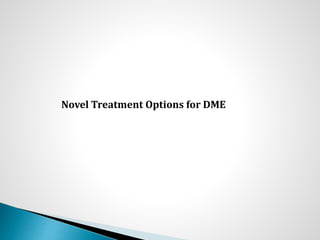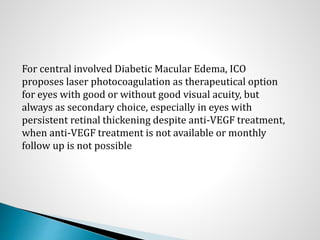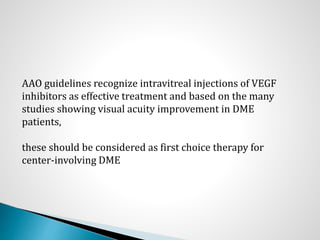DME Management Guidelines
- 5. Screening of diabetic patients: * type 1 diabetes: - all individuals ≥ 15 age, -5 years after diagnosis, *type 2 diabetes at diagnosis. If retinopathy is detected, then sight-threatening DR treatment should be introduced. Monitoring of the disease progress to be continued at least once per year. If DR is not present, then re-screening rhythm should be assigned, annually in all type 1 diabetes and type 2 diabetes every 1-2 years
- 6. AAO recommends follow up of DME progression at annual basis, irrespectively to type of mellitus
- 7. In diabetes, vision loss is most commonly the result of: -diabetic retinopathy (DR) (neovessels) -diabetic macular edema (DME)
- 9. DME Structural changes of DME are characterized by the accumulation of liquid and hard exudates in the outer plexiform and inner nuclear layers of the macula and formation of fluid-filled cystoid spaces.
- 10. (WESDR) in the USA found that 20% of patients with type 1 diabetes and 14%-25% of patients with type 2 diabetes developed DME over a 10-year follow up period.
- 15. RT values are classified as: 1. normal 2. borderline 3. edema (definite thickening)
- 17. 1. Fixation Point: thickness at the point of fixation, as reported in the Table “Eye Information” of the Retinal Map. Normal: 150 ± 20m Borderline: 170–210m Edema: ≥ 210m
- 18. 2. Central Zone: Normal: 170 ± 20m Borderline: 190–230m Edema: ≥230m
- 19. 3. Perifoveal and peripheral areas: Normal: 230 ± 20m Borderline: 250–290m Edema: ≥290m
- 24. On the authority of Wilkinson et al. Diabetic Macular Edema is classified to: mild – where some retinal thickening or hard exudates in posterior pole but outlying from the center of the macula, moderate where retinal thickening or hard exudates approaching the center of the macula but not involving the center and severe, where retinal thickening or hard exudates involving the center of the macula
- 25. Diabetic macular edema develops and progresses as a result of the interaction of different non-modifiable and modifiable risk factors
- 26. Diabetes duration is the most important ( non- modifiable) risk factor directly associated with the incidence and prevalence of DME in patients with both types of diabetes.
- 27. Hyperglycemia is the strongest (modifiable risk factor) for the development and progression of DR and DME. The Diabetes Control and Complications Trial (DCCT) in type 1 diabetes and the United Kingdom Prospective Diabetes Study (UKPDS) in type 2 diabetes found that tighter control of glycemia (HbA1c ≤7%) significantly reduced the risk of development and progression of DR, DME, vitreal hemorrhage and need for laser treatment, as well as the risk of blindness.
- 28. The DCCT also found that intensive glycemic control was associated with 46% reduction in the incidence of DME at the end of the trial and 58% reduction 4 years later compared with those in the conventional group.
- 29. Hypertension is also an important modifiable risk factor for DME. Each 10-mm Hg increase in systolic blood pressure was associated with an approximately 15% additional risk of DME. In the UKPDS, patients with hypertension with tight blood pressure control had a 34% reduction in the rate of progression of DME and 47% reduction in deterioration of visual acuity (VA).
- 30. Some clinical trials also showed that specific blood pressure- lowering medications that target the renin-angiotensin system had additional beneficial effects on DR and DME, independently of their hypotensive actions.
- 31. Dyslipidemia has a significant role in the pathogenesis of DME; some studies report that serum lipids were independently associated with DME. The Fenofibrate Intervention and Event Lowering in Diabetes (FIELD) study showed that fenofibrate reduced the frequency of laser treatment for DME by 31% in type 2 diabetes
- 32. Other non-modifiable and modifiable risk factors are puberty, pregnancy, genetic factors, nephropathy, obesity and smoking
- 34. RCO identifies four main therapeutic options of the DME treatment. These are : -laser photocoagulation, -intravitreal steroid treatment, - intravitreal VEGF inhibitors -polytherapy of laser photocoagulation + anti-VEGF or + intravitreal steroid treatment
- 35. Traditional Treatment of DME
- 36. Ideal metabolic control of diabetes, assuming strict control of well-known modifiable risk factors of hyperglycemia, hypertension, dyslipidemia and others, is the primary goal of treatment and the basic way of preventing and stopping the progression of DME.
- 37. Laser photocoagulation has been the primary treatment for DME since the early 1980s. The role of laser in preventing visual loss and blindness due to DME was established in 1970s-1980s by two large studies, the Diabetic Retinopathy Study (DRS) and the Early Treatment Diabetic Retinopathy Study (ETDRS)
- 38. The ETDRS demonstrated that photocoagulation reduced the risk of moderate vision loss caused by DME in about 50% of the eyes, in only 3% of eyes this therapy led to improvement of VA, and in the rest VA unfortunately remained poor due to persistence of macular edema
- 39. According to the studies referred by Canadian experts, laser treatment reduces loss of vision by 90% in severe DR proliferative on non-proliferative retinopathy and by 50% the incidence of visual loss in clinically significant macular edema (CSDME)
- 43. The potential complications of macular laser include : laser scar expansion, paracentral scotomata, elevation of central visual field thresholds, secondary choroidal neovascularization and subretinal fibrosis.
- 44. Novel Treatment Options for DME
- 45. DRCR Network group recommends a modified ETDRS focal/grid laser regimen(MLT) as follows: all leaking microaneurysms 500 to 3000 μm from fovea should be treated directly with 50 μm spot size, duration 0.05-0.1 s and intensity to achieve grayish reaction; grid treatment should be performed to areas of retinal thickening from 500 to 3000 μm superiorly and inferiorly and to 3500 μm temporally with a space of two burns width apart
- 48. Corticosteroids Corticosteroids are potent anti-infl ammatory agents that can counteract many of the pathological processes thought to play a role in the development of macular edema. They prevent leukocyte migration, reduce fibrin deposition, stabilize endothelial cell tight junctions, and inhibit synthesis of vascular endothelial growth factor (VEGF), prostaglandins and pro-inflammatory cytokines
- 51. Recently, the DRCR.net found that IVTA had best effect on VA improvement within 4 months of the application and that this effect was transient. A longer-lasting and doubling effect on VA was achieved only by using the IVTA plus focal/grid laser treatment
- 52. Anti-VEGFs Four VEGF-binding agents are currently used for ocular diseases: pegaptanib, bevacizumab (off -label), ranibizumab and afl ibercept.
- 53. DRCR.net Protocol T showed that intravitreal aflibercept, bevacizumab and ranibizumab improved vision in eyes with center-involved DME, but the relative effect depended on baseline VA. When the initial VA loss was mild, there were no differences among study groups. At worse levels of initial VA, aflibercept was more effective in improving vision
- 55. The ICO classifies diabetic eyes as having : -no Diabetic Macular Edema, -non-central involved DME and -central-involved DME
- 56. For non-central involved DME, ICO experts recommend the disease progress assessment every 3 months, for central involved DME every 1 month
- 58. ICO guidelines pay special attention to OCT, describing this method as the most sensitive in DME identification, that allows quantitative disease assessment
- 59. laser photocoagulation persists preferred treatment for noncenter-involving macular edema
- 60. Patients with high levels of sub-retinal hard exudates and increased serum lipids might be at higher risk of sub- retinal fibrosis development after the photocoagulation
- 61. ICO guidelines consider laser photocoagulation for both non-central involved and central involved DME. For non-central involved DME focal laser is advised to leaking microaneurysms‚ if thickening is threatening the fovea’. No treatment is recommended to lesions closer than 300- 500 μm from the center of the macula
- 62. For central involved Diabetic Macular Edema, ICO proposes laser photocoagulation as therapeutical option for eyes with good or without good visual acuity, but always as secondary choice, especially in eyes with persistent retinal thickening despite anti-VEGF treatment, when anti-VEGF treatment is not available or monthly follow up is not possible
- 63. AAO guidelines recognize intravitreal injections of VEGF inhibitors as effective treatment and based on the many studies showing visual acuity improvement in DME patients, these should be considered as first choice therapy for center-involving DME
- 64. In the first year of treatment 8-10 injections are considered, in the second year 2-3 injections, in the third year 1-2 injections and in the fourth and fifth year of treatment 0-1 injections
- 66. As per ICO guidelines for eyes with persistent retinal thickening complementary treatment of laser photocoagulation is considered
- 67. International Council of Ophthalmology guidelines identify precisely five indications for vitrectomy in DME (13): 1. Severe vitreous hemorrhage of minimum 1-3 months duration that does not disappear automatically. 2. Advanced active proliferative DR that persists despite extensive pan retinal photocoagulation. 3. Recent traction macular detachment. 4. Combined traction-rhegmatogenous retinal detachment. 5. Tractional macular edema or epiretinal membrane involving the macula.




































































